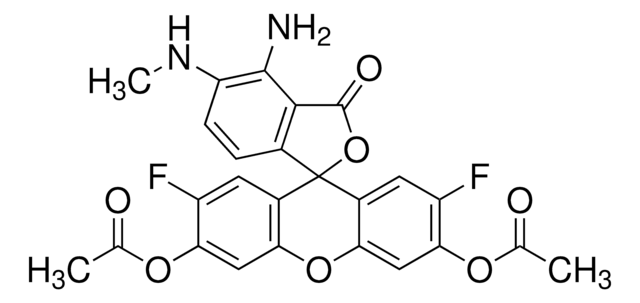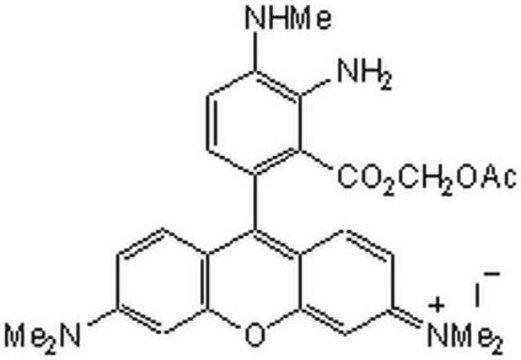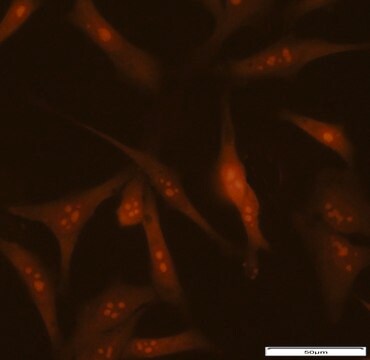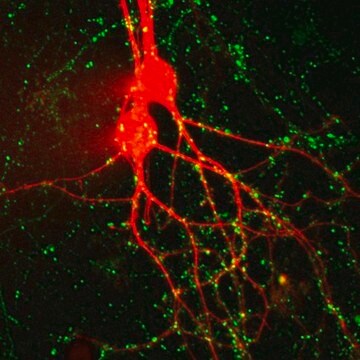SCT053
BioTracker SiRNO (Nitric Oxide)- Near Infrared Live Cell Dye
Live cell imaging dye for cellular nitric oxide (NO) localized to mitochondria and lysosome, used as an indicator of host defense, homeostasis and developmental functions.
Synonyme(s) :
Live cell imaging probe
Se connecterpour consulter vos tarifs contractuels et ceux de votre entreprise/organisme
About This Item
Code UNSPSC :
12352207
Nomenclature NACRES :
NA.47
Produits recommandés
Essai
≥98% (H-NMR)
≥98% (HPLC)
≥98% (LC/MS)
≥98% (elemental analysis)
Technique(s)
cell based assay: suitable
Méthode de détection
fluorometric
Description générale
Nitric oxide (No) is a reactive nitrogen species which is produced by nitric oxide synthase (NOS). NO is involved in many physiological processes including regulation of blood pressure, homeostasis, activation of immune system, neural communication, contraction of both smooth muscle and vascular tissue. Therefore, detection and quantification of NO is critical to understanding health and disease.
The BioTracker<TMSYMBOL></TMSYMBOL> SiRNO-Nitric oxide dye is a live cell near-infrared fluorescent imaging probe for detecting nitric oxide (NO). The probe targets NO specifically in the mitochondria and lysosome of living cells. The probe shows no cross reactivity to a variety of biomolecules and other reactive species including: ascorbic acid (AA), dehydroascorbic acid (DHA), methylglyoxal (MGO), GSH, Cys, Hcy, H2O2, ClO−, -OH, O2−, NO2−, and ONOO−. The SiRNO dye is pH insensitive in the range of 5.5 - 8.0, showing that it is suitable for physiological pH range. The SiRNO dye has been successfully used to detect NO in live cells, animal tissue and in vivo experiments.
Spectral Properties
Absorbance: 633nm
Emission: 650-750nm
The BioTracker<TMSYMBOL></TMSYMBOL> SiRNO-Nitric oxide dye is a live cell near-infrared fluorescent imaging probe for detecting nitric oxide (NO). The probe targets NO specifically in the mitochondria and lysosome of living cells. The probe shows no cross reactivity to a variety of biomolecules and other reactive species including: ascorbic acid (AA), dehydroascorbic acid (DHA), methylglyoxal (MGO), GSH, Cys, Hcy, H2O2, ClO−, -OH, O2−, NO2−, and ONOO−. The SiRNO dye is pH insensitive in the range of 5.5 - 8.0, showing that it is suitable for physiological pH range. The SiRNO dye has been successfully used to detect NO in live cells, animal tissue and in vivo experiments.
Spectral Properties
Absorbance: 633nm
Emission: 650-750nm
Application
Live cell fluorescent imaging
Live cell imaging dye for cellular nitric oxide (NO) localized to mitochondria and lysosome, used as an indicator of host defense, homeostasis and developmental functions.
Research Category
Cell Imaging
Cell Imaging
Research Sub Category
Live Cell Dye
Live Cell Dye
Qualité
Purity: ≥ 98% confirmed by HNMR, LC-MS and HPLC and elemental analysis
Molar Mass: 758.34 g/mol
Molar Mass: 758.34 g/mol
Forme physique
Lyophilized
Stockage et stabilité
Store BioTracker SiRNO-Nitric Oxide Live Cell Dye at -20°C, desiccate and protect from light
Note: Centrifuge vial briefly to collect contents at bottom of vial before opening.
Note: Centrifuge vial briefly to collect contents at bottom of vial before opening.
Clause de non-responsabilité
Unless otherwise stated in our catalog or other company documentation accompanying the product(s), our products are intended for research use only and are not to be used for any other purpose, which includes but is not limited to, unauthorized commercial uses, in vitro diagnostic uses, ex vivo or in vivo therapeutic uses or any type of consumption or application to humans or animals.
Code de la classe de stockage
11 - Combustible Solids
Classe de danger pour l'eau (WGK)
WGK 3
Point d'éclair (°F)
Not applicable
Point d'éclair (°C)
Not applicable
Certificats d'analyse (COA)
Recherchez un Certificats d'analyse (COA) en saisissant le numéro de lot du produit. Les numéros de lot figurent sur l'étiquette du produit après les mots "Lot" ou "Batch".
Déjà en possession de ce produit ?
Retrouvez la documentation relative aux produits que vous avez récemment achetés dans la Bibliothèque de documents.
Zhiqiang Mao et al.
Analytical chemistry, 89(18), 9620-9624 (2017-08-29)
Two-photon (TP) fluorescent probes are potential candidates for near-infrared (NIR) imaging which holds great promise in biological research. However, currently, most TP probes emit at wavelength <600 nm, which impedes their practical applications. In this work, we explored the TP
Notre équipe de scientifiques dispose d'une expérience dans tous les secteurs de la recherche, notamment en sciences de la vie, science des matériaux, synthèse chimique, chromatographie, analyse et dans de nombreux autres domaines..
Contacter notre Service technique







